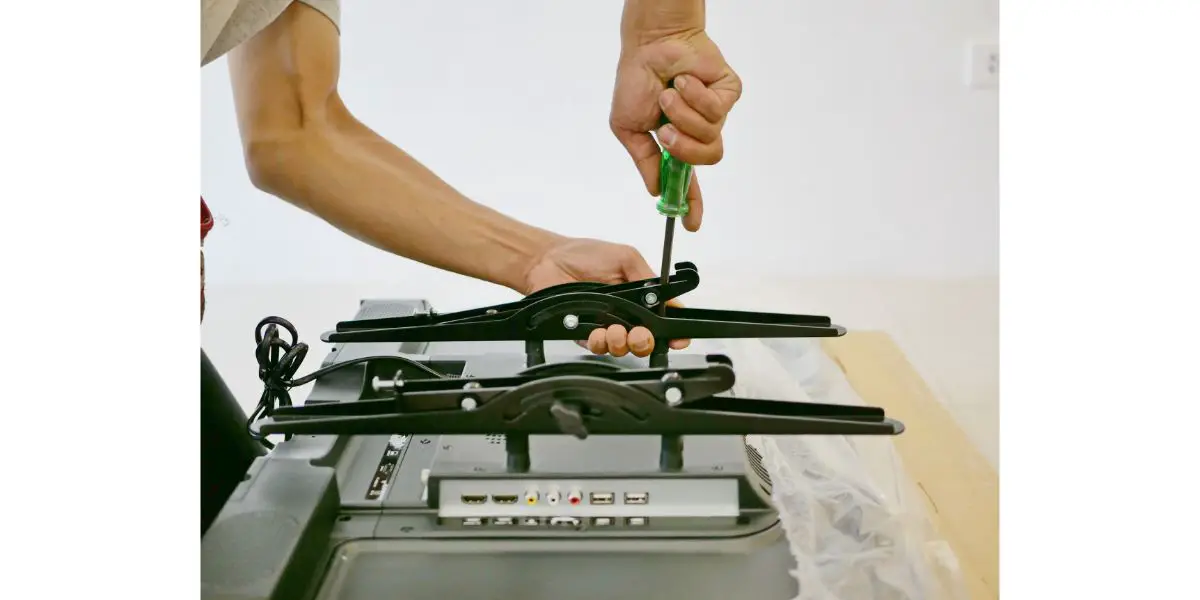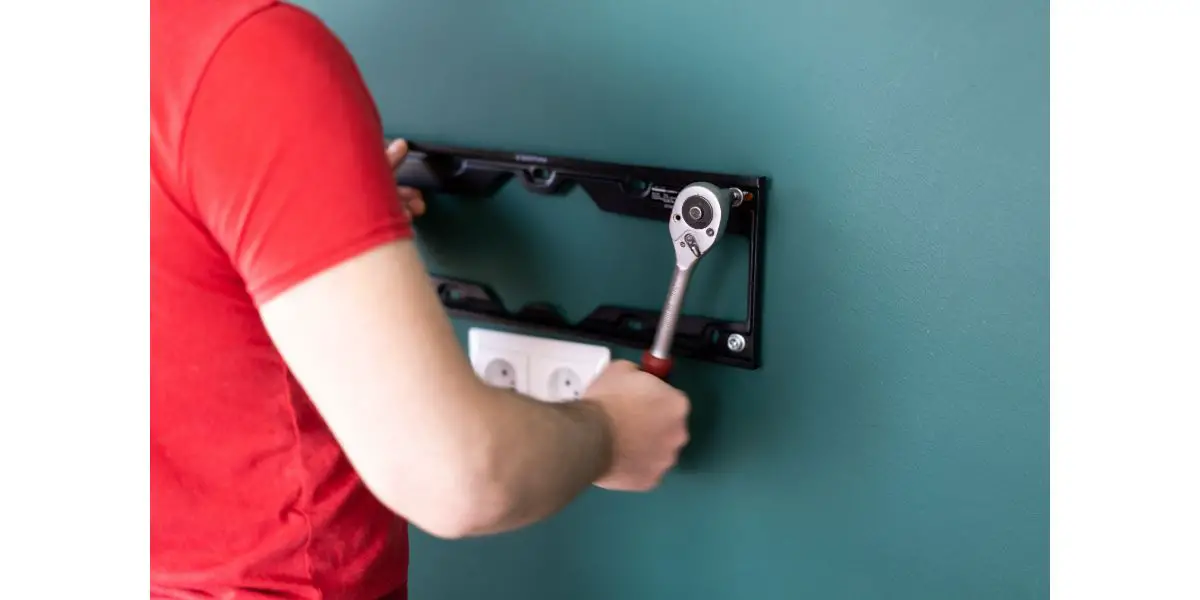Disclaimer: This post may contain affiliate links, meaning we get a small commission if you make a purchase through our links, at no cost to you. For more information, please visit our Disclaimer Page.
If you’re renting a place, you might be considering the amount of damage mounting a TV could cause. The added height benefit creates a great viewpoint for various angles in the room, but is it worth it?
We’ll walk you through all the possible damages with mounting TVs and how to do it safely to avoid excess destruction!
Table of Contents
Can Mounting a TV Damage the Wall?
Mounting a TV requires holes in the wall, so a small amount of damage will happen. You’ll have an average of four spots in the wall, directly over studs, if done correctly. These holes are usually small and easy to repair- just like repairs needed when you hang a picture on the wall.
The real damage happens when you don’t utilize studs while hanging your TV. The type of wall you are installing the mount on also affects the level of damage.
Plasterboard walls are not capable of holding much weight. It will start to crack if you attempt to hang a TV on the plasterboard. Eventually, that wall section will crash to the ground with the mount. That’s why finding studs is so important.
If your walls are concrete or brick, things get tricky. It’s nearly impossible to repair holes in these types of walls seamlessly. Ask your landlord for permission and find professional help to mount the TV if you have brick or concrete walls.
Another aspect of TV mounting is the cables. Many people do not consider that they will have cords hanging down from their TV after they mount it. Some opt to hide the wires in the wall- which requires further destruction. This option is really only for those who own their home and are not renting.
How to Safely Mount Your TV (Step-by-Step)
What You Will Need
- Manufacturer instructions: You must know how your particular mount attaches to your TV and the wall.
- Stud finder: We know that you could always attempt the “wall-knocking” technique 16 inches away from the corner, but using a stud finder will ensure you drill properly into a stud without having to woodpecker your way through the wall.
- TV mount: Obviously, if you’re mounting your TV, you’ll need a TV mount. You’ll want to find one that fits your dimensions and TV model.
- Pencil: It’s important to mark when you find a stud to help you remember where to drill. Painters tape is another great option for marking the wall, but pencils work just as well and are erasable.
- A level: You do not want to trust your eyes with a project like this one. Using a level can help ensure that your screen is not crooked and help you avoid creating more unnecessary holes.
- Power drill: A power drill is much faster than a handheld screwdriver.
- Drill bits: You’ll need two drill bits, a Phillips head, and a carbide-tipped masonry bit. The latter is great for creating pilot holes to mount screws in.
- An assistant (optional): TVs are big and awkward to carry. Asking a friend to help you mount your TV is a good way to avoid the risks of injuring yourself or your flatscreen.
Step 1: Pick Your Location
The first step to mounting your TV is to choose exactly where you want it. You should understand, however, that the location may get minorly adjusted due to stud locations.
Choose a spot that will be great for viewing your favorite shows from various angles in the room.
Step 2: Locate Studs
Pull out your stud locator and slide it across the wall until it lights up.
Studs are generally 16 inches apart from each other. You can also find them attached to outlets as well.
Step 3: Drill Pilot Holes
Once you choose your location and locate studs to anchor the mount into, you can drill your pilot holes.
Grab a friend to help you hold the mount up to the wall. Use the level to ensure it’s on their straight, then use your pencil to mark small holes for your drill. You can set the mount down afterward.
Attach the carbide-tipped masonry bit to your drill and create pilot holes on the marks.
Step 4: Attach the Mount to the Wall
Pick the mount back up and position it against the wall. Switch drill bits. While holding up the mount, drill the screws into place.
Step 5: Attach the TV
Ensure you remove your TV stand before attaching it to the wall.
Find the mounting plate holes on the back of your TV. There may be screws in those holes, so you might have to remove those first. Using provided hardware, attach the mounting plate to your TV.
Now comes the heavy part- mounting your TV to the wall. Grab your partner to help, as this can be tricky.
Lift the TV carefully by using your legs. Once lifted, line it up with the mount’s brackets on the wall. Follow the manufacturer’s instructions to connect the frame to the TV’s mounting plate. Every model differs, so reading the instructions is important.
After that, you’re all done and can enjoy your newly mounted TV.
How to Repair a Damaged Wall
So your plans didn’t go quite the way you wanted. If you damage your wall while mounting your TV, your landlord will likely request you fix or pay for it.
Follow these steps to patch up and repair a small hole:
- Fill in any small screw-size hole with a lightweight spackle and a putty knife. Ensure the spackle is flush with the wall and fills the gap.
- Let the spackle dry completely. 15 to 30 minutes is usually long enough, but you can check the manufacturer’s instructions on the container.
- After it dries, use sandpaper to smooth out the area.
- Wipe away any remaining debris and touch up the paint on that section.
If your drywall cracked over half an inch wide, follow these steps to repair it:
- Cover the crack with self-adhesive drywall tape.
- Spread the joint compound over the tape with a putty knife.
- Let the compound dry completely within the time suggested by the manufacturer. Afterward, sand it down using sandpaper.
- If the crack still appears prominent, apply another coat of joint compound.
- Once it looks covered and dry, remove debris and touch up the paint.
Below is a helpful video that we found that gets straight to the point of fixing drywall holes caused by a TV mount.
Alternatives to Mounting Your TV on the Wall
If you want your TV at a higher position, a wall mount is not your only option. Wall mounts leave your cords out in the open, dangling from your screen if you don’t hide them well.
Many people opt for tall storage options, such as entertainment centers, to set their TV higher. You can often find a great cabinet to repurpose or an old entertainment center at a thrift store.
Another option is to find a universal floor stand. These are what many people use to display a TV in an exhibition. It’s something you can easily take with you when you move. You can find them online at retailers.
Conclusion
Mounting your TV should not cause too much damage to your wall if done properly. Holes will always be required- but if you use studs to anchor the mount, the damage will be minimal.
If you’re renting, always talk to your landlord before attempting a large project that could create problems.


